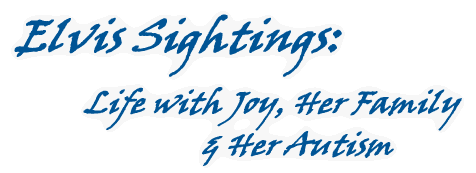I've got a brain-full again, with this LEND program stuff. And a schedule-full. Friday was the busy-est day I've had in a long time. Clinic observation, lunch conversation, interdisciplinary team meeting, lecture on ASDs, autism self-advocate/parent panel, trainee meeting for those of us with a special autism focus, an hour home for supper, then a glorious evening of Boggle-playing.
Spin, spin, spin! And almost every part of it (well, except slurping down the supper) was reflection-worthy.
But I'm only going to blog about the panel. Four speakers, a 30-something-year-old man who has autism, his mom, his support broker, and another mom of 4 kids with the youngest two on the spectrum.
The star speaker was a fascinating guy. He has a university bachelor's degree in mathematics (!), his own apartment, and a patchwork of 3 jobs (not all paid.) He and his mom and support broker make up a formidable team! He read his speech in not quite a monotone, but less inflected than most folks would do. There were definitely intentional laugh-lines in there though: "The last thing my parents expected was to see me on the speaking circuit, but here I am!" One thing that struck me personally was when he described how he used to take his mom's hand and throw it at the cookie-jar. He said he did that because the hand was what gave him cookies. It didn't occur to him that it made a difference that the hand had a mom attached. Yikes -- Joy has been doing that hand-flinging thing with us, especially at the dinner table if she sees something she wants that's not on her plate.
For all his mathematical brilliance, and his amazing origami creations, and the stunning fractal art he creates on his computer, he doesn't have an easy time of it. He described it as literally painful for him to make eye contact, which in and of itself is a pretty major social barrier. He has various sensory sensitivities that take constant energy to deal with. He has a hard time with ambiguities or changes in plan -- we saw it happen when his cell phone rang during his speech, and he temporarily froze. I don't know what would have happened next if his mom had not been there to calmly advise him to turn off the phone and make sure he followed through.
His mom is a practiced speaker as well, a devoted advocate, and kept throwing out one zinger after another.
"There's what, 40 students in this room? At least four of you will probably have a child with a disability. You just don't know who you are yet."
Her perspective on the role she & the staff play for her son is that he outsources the administrative work to them. Like the deadly paperwork. Like, for instance, when his father retired, which caused him to have to accept a slightly different flavor of Social Security, which put his income just slightly over the limit allowed by his medical assistance...
The other mom was a disability rights activist and LEND graduate, very likeable and engaging speaker. What I'm chewing over from her presentation was her announcement that she has a "secret doctor" for her spectrum children. "The primary care doctor that we see is... how can I say this...
rigid." Rigid, in this case, meant that the doctor wouldn't prescribe hyperbaric oxygen treatment (HBOT). HBOT is an "alternative" therapy, not FDA approved for autism treatment -- here's what one of my favorite skeptics,
Prometheus at A Photon in the Darkness, has to say about HBOT. Anyway, this mom takes her kids down to Florida to be treated by a doctor who has kids on the spectrum himself and practices HBOT. So the 130 HBOT treatments that the one son has had, she feels are a great investment, but they're a secret from his regular doctor.
Oh-my-goodness. In other words, her kids' PCP is missing important information about a huge treatment component. Her story really caught me by surprise. I'm aware, of course, of parents who switch doctors when they decide they want to do alternative treatments and the first physician doesn't approve. This "secret doctor" situation hadn't occurred to me though.
I have to confess that a big part of my empathy goes with the physician, with what little I know about this particular story. What's a medical provider to do? How to stick to one's medical principles, and advise people against treatments that the science & your expertise & training tells you are worthless at best and dangerous at worst, without being so "rigid" that your patients end up going behind your back? Is it better that this "rigid" doctor keeps seeing the kids without knowing the full story, or would it be better for mom to just go ahead and switch, to seek primary care with someone who supports the treatments of her choice? How often does this happen, I wonder, that parents keep one foot in each world and the Western/allopathic/evidence-based doc doesn't know what's happening with the patient's alternative treatments? (Have you done it yourself, if you're still with me after this paragraph? If so, how does that fit for you?)
The most chilling words from the panel, though, came from the support broker. "People ask me when to start preparing for the transition to adult services -- and I say, 'At birth' and I'm only partly kidding." We'd heard last month about the
waiting list for housing support in the community from a family panel of LEND faculty. This woman put it even more starkly: "People are not getting off that waiting list until their parents DIE. And then the system goes into crisis mode, and finds something for them, that might not be the best thing..."
The thought about preparing for adult services transition during childhood -- kinda makes me want to curl up in the fetal position and stick my fingers into my ears. Joy's FIVE, fer cryin' out loud. We have no idea who she'll be at age 21 and beyond, and what she'll be capable of. And it's not like we don't have plenty of plates in the air already. And it's not like the service structure might not be totally different in a decade and a half. But the support-broker lady did make an interesting comment about the utility of the forward-looking perspective: "Instead of teaching them a busy-box, teach them a tape-recorder." Hmm.
The mathematician's mom chimed in too, saying that her rule of thumb was to start exploring services five years before they were needed. This led her to the Department of Vocational Rehabilitation (DVR) when her son was 15 or so. The guy at the DVR was a little incredulous - "We can't do anything for him at this age! Come back again when it's time." But then she asked him what he would do if it were his child. And he said that he'd emphasize putting together a resume as early as possible. Keep track of anything that could possibly be construed as any kind of work experience whatsoever, and get it documented early. And that, she found, was a huge help.
The whole realm of thinking about adult services seems to be coming at me from several angles this past week or two. The new issue of
Autism Advocate from the Autism Society of America focuses on adult services. And the social work class on developmental disabilities that's part of my LEND experience is in the middle of a unit on adult services too.
One frustrating thing about the
online social work lectures is that the lectures were recorded over a span of years, and it's not clear how old each one is. I think some may be almost 10 years old, and the others just a couple of years. It serves well for the history of services in Wisconsin, but not so much with the cutting-edge state of affairs.
There are some major success stories around the history of services for people with developmental disabilities. One lecturer said that back in the 1930s, when institutionalization was THE option, life expectancies were down around 19 years (he didn't qualify that with who exactly "counted" as being in that group). Basically, hardly anyone in that group outlived their parents. By the 1970s, it had shot up to 59; more recently, it's more like 66!
A parallel success story is that starting in 1980s in Wisconsin, people started being moved from the institutions into the community, with the support & dollars following them. The lectures are full of examples from this effort, and we also heard about
one such fellow from his guardian in the previous family panel seminar. If I'm understanding it correctly, that movement continues, and I've heard rumor that one of the three major Wisconsin institutions is slated to actually close its doors at some point in the foreseeable future!
But then there's also the parallel victims-of-their-own-success stories (depending on how you look at it!) All these kids who have been able to grow up well-supported at home, with services from Birth to Three and the schools... living plenty long enough to go out on their own, if only the supports were there! Instead, though, we've got the waiting lists. A less hopeful statistic from another of the lectures claimed that only 12-15% of people with intellectual disabilities ever live outside the family home...
My brain is full. And there are soooo many things to work on for the future!



























